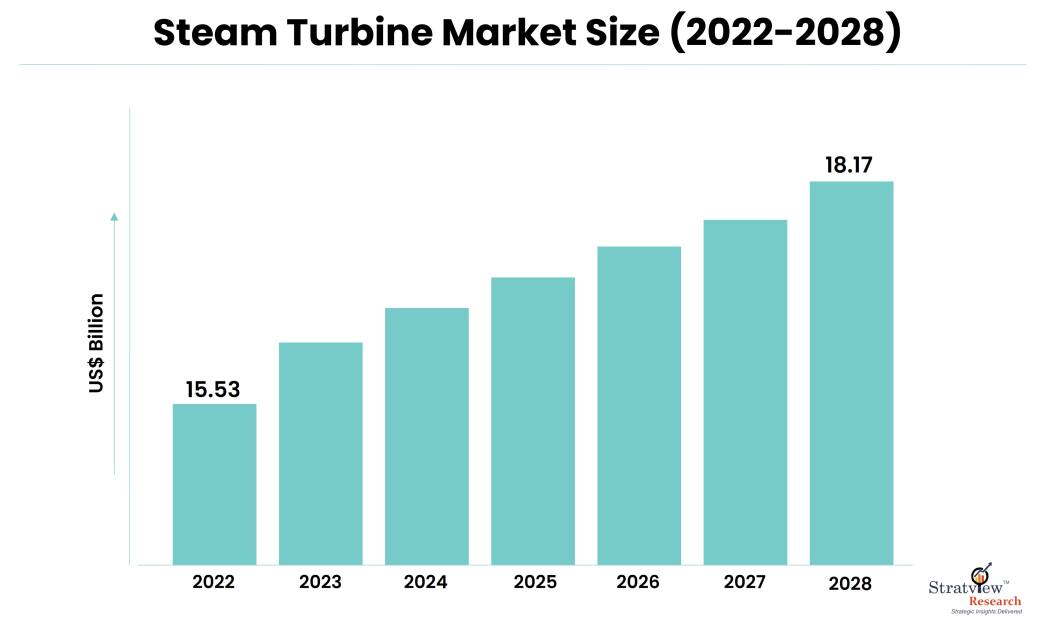Steam turbines have long been a cornerstone of power generation, providing reliable and efficient energy for various industries and applications. However, in recent years, the steam turbine market has witnessed significant changes, driven by technological advancements, environmental concerns, and shifting energy landscapes. This article explores the evolving landscape of the steam turbine market, highlighting emerging trends, challenges, and opportunities. The steam turbine market is estimated to grow from USD 15.53 billion in 2022 to USD 18.17 billion by 2028 at a CAGR of 2.60% during the forecast period.
Increasing Focus on Efficiency and Flexibility:
Efficiency has always been a key consideration in the steam turbine market, and manufacturers are continuously striving to enhance turbine performance. Advanced technologies such as combined cycle systems, supercritical and ultra-supercritical steam conditions, and improved materials are being employed to achieve higher efficiency levels. Additionally, the demand for flexible operation, including quick startup and shutdown capabilities, is growing to accommodate intermittent renewable energy sources. Turbine manufacturers are investing in research and development to meet these evolving requirements.
The transition towards Clean Energy:
The global shift towards clean and sustainable energy sources has had a profound impact on the steam turbine market. With increasing concerns about climate change and the need to reduce greenhouse gas emissions, there is a growing emphasis on renewable energy technologies. Steam turbines are being integrated with biomass, geothermal, and concentrated solar power plants, enabling the efficient conversion of heat into electricity. This transition presents significant opportunities for turbine manufacturers to expand their product portfolios and cater to the evolving needs of the energy market.
Integration of Digitalization and Automation:
The advent of digitalization and automation has revolutionized the steam turbine industry. Advanced sensors, data analytics, and machine learning algorithms are being used to monitor turbine performance, optimize maintenance schedules, and improve overall operational efficiency. Predictive maintenance techniques are being employed to detect and address potential issues before they result in costly breakdowns. Furthermore, digital twin technology is gaining prominence, allowing operators to simulate and optimize turbine performance under various operating conditions. These technological advancements offer enhanced reliability, reduced downtime, and improved decision-making capabilities.
Challenges in the Transition Period:
While the steam turbine market presents numerous opportunities, it also faces certain challenges during this transitional phase. One major hurdle is the phasing out of traditional coal-fired power plants, which have traditionally been the primary users of steam turbines. The decline in demand for coal-based power generation necessitates a shift towards alternative energy sources and the repurposing of existing infrastructure. This transition requires careful planning, investment, and collaboration between stakeholders to ensure a smooth and sustainable transition.
Regional Market Dynamics:
The steam turbine market is highly influenced by regional dynamics. Developed economies are focused on upgrading aging power infrastructure and replacing conventional plants with cleaner alternatives. In contrast, emerging economies are witnessing a surge in electricity demand, driven by rapid industrialization and urbanization. These countries present significant growth opportunities for steam turbine manufacturers as they seek to meet their increasing energy needs. Additionally, policy frameworks, government incentives, and regulatory requirements vary across regions, influencing market dynamics and shaping the strategies of industry players.
In conclusion, the steam turbine market is undergoing a transformative phase, driven by the need for increased efficiency, clean energy solutions, and digitalization. As the industry adapts to these changing dynamics, there are ample opportunities for innovation, product diversification, and market expansion. However, challenges related to the phasing out of coal-based power generation and regional variations in market dynamics need to be addressed. Overall, the evolving landscape of the steam turbine market presents an exciting future with immense potential for growth and sustainable energy solutions.





Comments